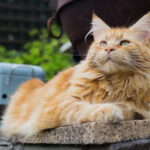Domestic Longhair Cats are a delightful mix of mystery and charm. Unlike purebred longhaired cats, the Domestic Longhair is a breed of mixed ancestry, defined by their luxurious long coat rather than a specific pedigree. These beautiful felines are essentially your typical cat, Felis silvestris catus, but with the added flair of flowing, magnificent fur. They’ve graced homes and hearts for centuries, earning their spot as the second most popular cat type in the United States, just after their shorthaired cousins, the Domestic Shorthair. Their widespread appeal is no surprise; each Domestic Longhair is a unique blend of genes, resulting in a stunning variety of appearances and personalities.
 domestic longhair tabby cat resting on a blue and white blanket
domestic longhair tabby cat resting on a blue and white blanket
Unraveling the Hairy History of Domestic Longhair Cats
To understand the Domestic Longhair cat, we must delve into their genetic makeup. The long hair trait in cats is recessive. This means that when a shorthaired cat and a longhaired cat mate, their kittens will likely inherit the dominant shorthaired trait. However, if these shorthaired offspring carry the recessive longhair gene and mate with each other, there’s a chance they will produce longhaired kittens. This genetic dance has allowed longhaired cats to emerge naturally across populations.
Natural Origins and Adaptation
The precise origin of the Domestic Longhair remains speculative, but a leading theory suggests natural selection played a significant role. It’s believed that the recessive gene for long hair became more prevalent in cat populations inhabiting colder climates. In regions like Russia, Iran, and Turkey, a thick, long coat offered a survival advantage, providing crucial insulation against harsh weather conditions. This adaptation mirrors that of wild cats like the Pallas cat, a captivating creature from Central Asia known for its long, dense fur and somewhat grumpy expression. While once rumored to be an ancestor of the Domestic Longhair, this theory has been disproven, highlighting the independent evolution of long hair in domestic cats.
From Plague Fighters to Immigrants
While deliberate breeding programs eventually led to refined longhaired breeds like Persians and Russian Blues, the resilient Domestic Longhair continued to thrive naturally. Historical records first mention them in Italy around the 16th century. Their arrival in Europe is often attributed to soldiers returning from the Crusades, who may have brought these longhaired felines with them. This migration proved fortuitous, especially during the devastating plague outbreaks that swept through Europe in the mid-1600s. Domestic Longhair cats, with their exceptional mousing abilities, became invaluable allies in controlling rat populations, which were carriers of disease-spreading fleas. This practical benefit helped restore cats to a favored position in society after periods of religious disapproval.
Later, Domestic Longhairs journeyed to America aboard ships, serving as indispensable ship’s cats. Some of these seafaring felines may have evolved into the beloved Maine Coon breed, known for its impressive size and long fur. Others continued to contribute to the diverse gene pool of Domestic Longhairs, resulting in the stunning variety of longhaired cats we see in homes today.
Humphrey: A Famous Feline Figure
Among the many Domestic Longhair cats who have made their mark, Humphrey stands out. This black and white cat began his life as a stray on the streets of London before becoming a political figure. Discovered near the British Prime Minister’s residence at 10 Downing Street at just one year old, Humphrey quickly charmed his way into the hearts of the governing elite.
He was officially appointed “Mouser to the Cabinet Office,” a title he apparently earned through dedicated service. The British government even allocated funds for his food, recognizing his important role. Humphrey served at 10 Downing Street through the tenures of three Prime Ministers, becoming a beloved figure for both the public and the press. After a distinguished career in politics, Humphrey retired to a peaceful country home, living to the remarkable age of 18.
Defining Domestic Longhair Traits: A Spectrum of Splendor
The mixed heritage of Domestic Longhair cats is what makes them so endlessly fascinating. They exhibit a breathtaking array of colors, physical characteristics, and personality nuances. The unifying feature, of course, is their beautiful long hair, which sets them apart from their shorthaired counterparts. Think of words like flowing, lustrous, and silky when envisioning their coats.
A Kaleidoscope of Coat Colors
The hallmark of the Domestic Longhair is their coat, typically ranging from two to six inches in length. Many boast impressive neck ruffs, adding to their regal appearance. Ear tufts and paw tufts are also common, remnants perhaps of their ancestors’ adaptation to colder climates, where paw tufts could have acted like snowshoes or provided stability on sandy terrain for desert-dwelling ancestors.
Color and pattern diversity is a defining trait. Domestic Longhairs can be found in virtually every feline color and pattern combination imaginable, often paired with a striking variety of eye colors. This incredible spectrum ensures there’s a Domestic Longhair to capture every cat lover’s heart.
Common coat colors and patterns include:
- Smoke
- Tabby (classic, mackerel, ticked)
- Patched Tabby (torbie)
- Tuxedo
- Calico
- Solid Black
- Faun
- Patched Faun
This extraordinary variation in appearance is a key reason for their popularity – you can find a Domestic Longhair in almost any color and pattern you desire.
Body Structure and Size
Body types in Domestic Longhairs are as diverse as their coat colors, influenced by the myriad of breeds present in their genetic background. Their facial features can range from elongated to rounded, and their bodies may be muscular or slender.
However, their overall size generally falls within the medium range for cats. The average Domestic Longhair cat weight is between 8 to 15 pounds, with males typically being larger than females. Their body length averages around 18 inches, complemented by a tail approximately 12 inches long.
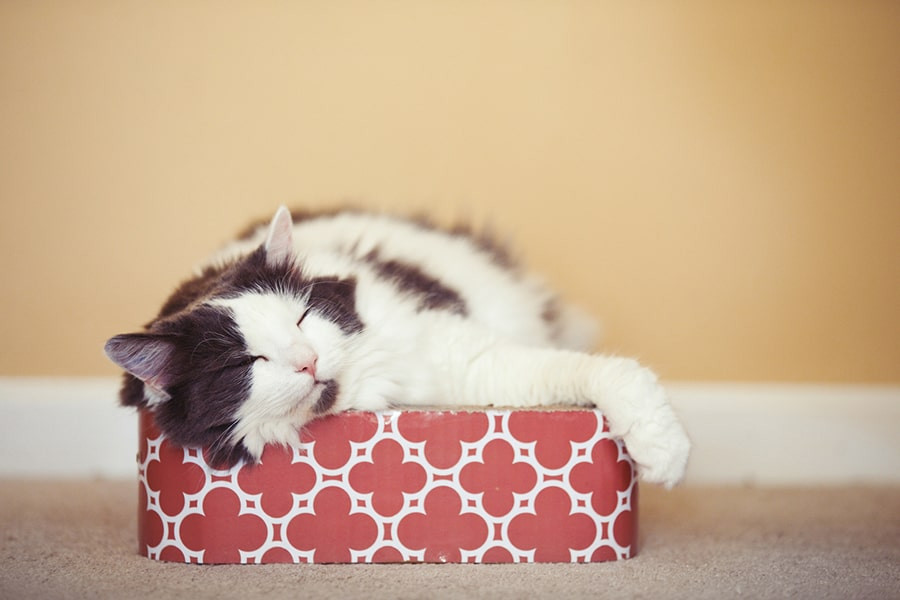 gray and white domestic longhair cat sleeping on a red and white scratcher bed box
gray and white domestic longhair cat sleeping on a red and white scratcher bed box
Domestic Longhair Personality: Adaptable and Affectionate
One of the most appealing aspects of Domestic Longhair cats is their balanced temperament. They are known for being neither overly aloof nor excessively demanding. While individual personalities vary, with some being quieter or more affectionate than others, they generally avoid extremes. This adaptability makes them wonderful companions for a wide range of households.
A consistent personality trait among Domestic Longhairs is their innate hunting drive. Their exceptional mousing skills are, after all, a significant reason for the long-standing partnership between humans and cats. Expect your Domestic Longhair, particularly when young, to enjoy engaging in play that mimics hunting, such as stalking interactive toys.
Essential Care for Your Domestic Longhair
The primary consideration when caring for a Domestic Longhair cat is their luxurious coat. While some longhaired breeds are naturally adept at grooming, Domestic Longhairs often require human assistance to maintain their fur in top condition. Unlike breeds like the Maine Coon, whose coat is somewhat more mat-resistant, many Domestic Longhairs with thick fur need regular grooming to prevent matting and hairballs.
Consistent grooming is key. Plan to dedicate time each week to brushing your longhaired feline. Daily brushing can be particularly beneficial in preventing mats. If mats do develop, seeking the help of a professional feline groomer is advisable to avoid injury to both yourself and your cat during the removal process.
Bathing may occasionally be necessary, especially for kittens. If you need to bathe your Domestic Longhair, research proper cat bathing techniques beforehand to ensure a stress-free experience for both of you.
Beyond coat care, routine veterinary check-ups are crucial for maintaining your cat’s overall health. Schedule a vet visit soon after adopting your Domestic Longhair for a comprehensive health assessment and to discuss their specific nutritional and healthcare needs.
Indoor living is highly recommended for all cats, including Domestic Longhairs. Keeping your cat indoors protects them from injuries, illnesses, and contagious diseases prevalent in outdoor environments. Given their natural hunting instincts, indoor Domestic Longhairs will also help protect local wildlife.
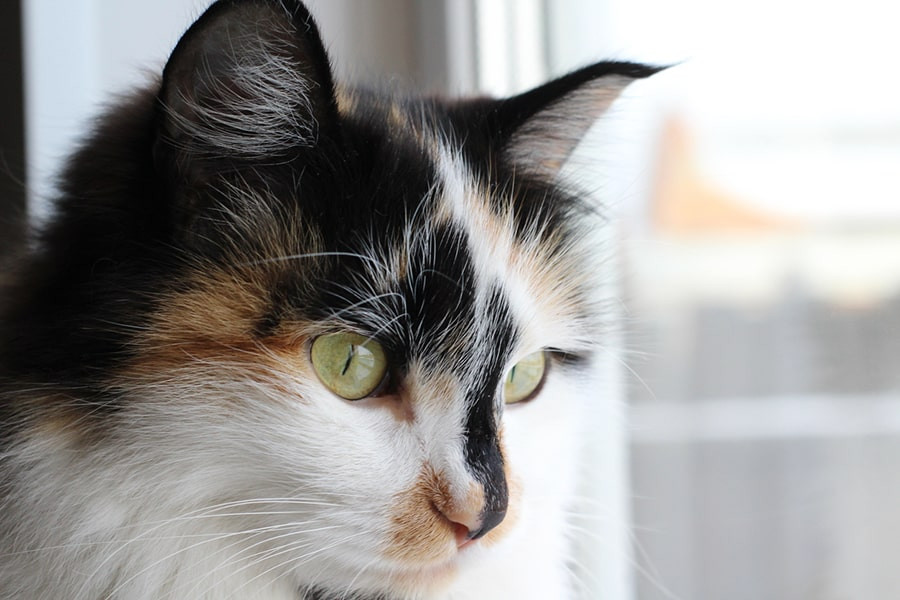 calico domestic longhair cat with green eyes looking out a window
calico domestic longhair cat with green eyes looking out a window
Common Health Concerns in Domestic Longhair Cats
Thanks to their mixed-breed background, Domestic Longhair cats are not predisposed to specific hereditary health issues. However, like all cats, they can be susceptible to general feline health problems such as arthritis, upper respiratory infections, and cancer.
According to claims data, the most common health issues observed in Domestic Longhair cats include:
- Vomiting
- Upset stomach (gastrointestinal issues)
- Hyperthyroidism
- Kidney disease
- Loss of appetite
Annual veterinary check-ups are essential for preventative care and early detection of potential health problems. Even if your Domestic Longhair appears healthy, these routine visits allow your veterinarian to identify subtle health changes that cats are adept at hiding.
Adopting Your Domestic Longhair Companion
Domestic Longhair cats are abundant; it’s estimated that they constitute approximately 10% of the domestic cat population in the U.S. This widespread presence means you’re likely to find many wonderful Domestic Longhairs awaiting adoption at your local animal shelter.
The incredible variety within the Domestic Longhair type makes it easier to find a cat that perfectly matches your preferences and lifestyle. Once you’ve found your feline soulmate, spaying or neutering is highly recommended. This procedure offers numerous health benefits, potentially extending your cat’s lifespan and preventing certain health issues, as well as preventing unwanted litters.
To begin your search for a Domestic Longhair to adopt, visit the ASPCA’s website to locate a shelter near you. They can guide you through the adoption process and provide valuable information on initial kitten or cat care.
* Internal Claims Data, 2020. The information provided in this article is intended for general knowledge and informational purposes only, and does not constitute veterinary advice. Always consult with a qualified veterinarian for any health concerns or before making any decisions related to your pet’s health or treatment.
RELATED ARTICLES
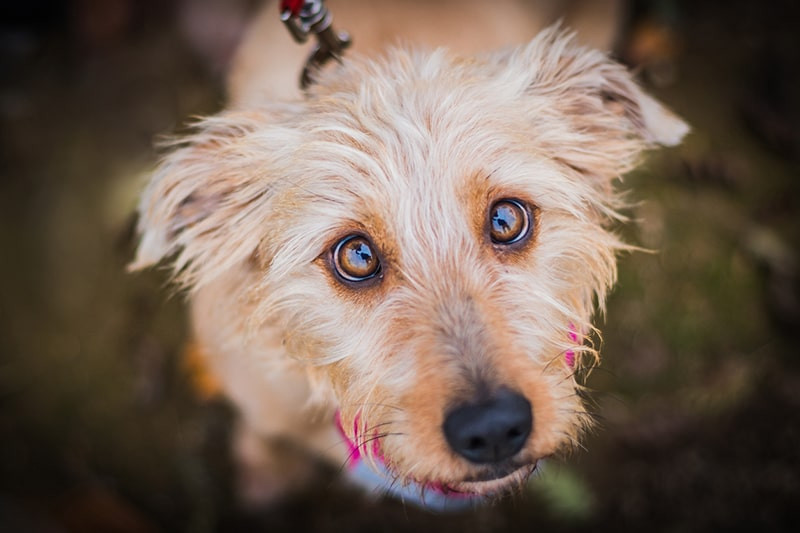 terrier mixed dog looking directly into the camera
terrier mixed dog looking directly into the camera
All About Mixed Breed Dogs
Mixed breed dogs may look like purebred dogs, but you will be surprised to learn just how many breeds exist in your dog’s ancestry.
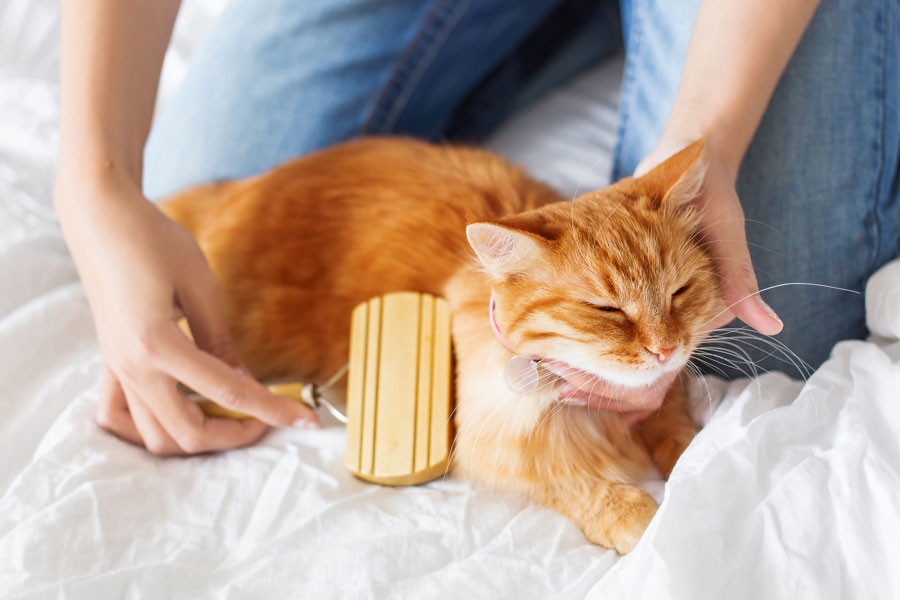 A person gently brushing an orange cat.
A person gently brushing an orange cat.
How to Groom Your Cat
Grooming your cat is key to their health and happiness. From brushing to nail trims, learn tips to keep them looking and feeling their best!
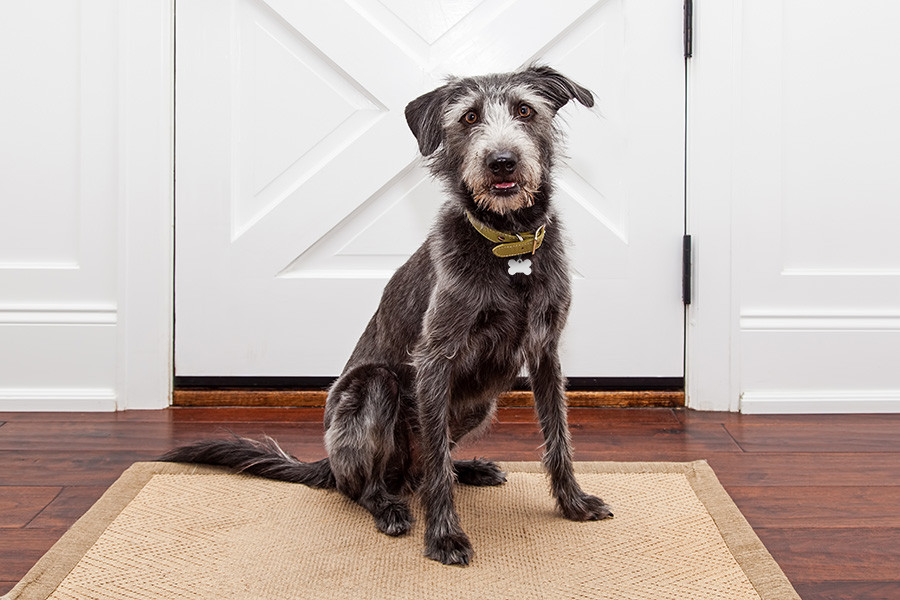 A mixed breed dog sitting on a mat in front of a door.
A mixed breed dog sitting on a mat in front of a door.
Dogs and Delivery Drivers
Learn about the relationship between your dog and the mail carrier and how to deal with barrier aggression, barking at the door, and territorial pups.

